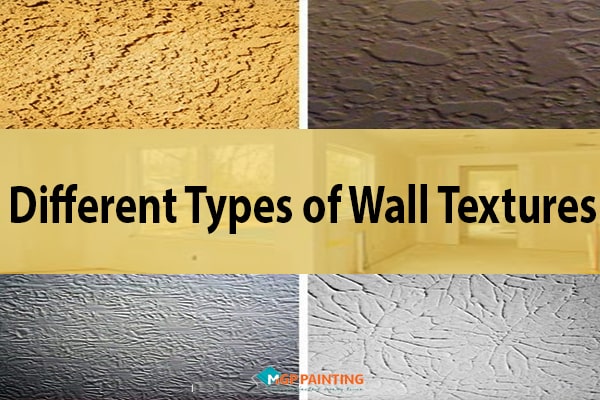
Different Types of Wall Textures
A long-lasting new paint texture can revamp the views and touch of the canvas. It transforms your space into a loving abode.
Today, modern technology makes it possible to establish cost-efficient different textures that can be created by adding various materials like sand, lace, ribbons, metals, leather, wood, etc.
All these different wall textures provide a distinctive look to the walls without harming the environment and immediately lift the appeal of the home’s interior.
Classifying wall textures includes segregating popular classifications of paint and much more.
Let us take a look at some different types of wall textures:
1. Popcorn Wall Texture
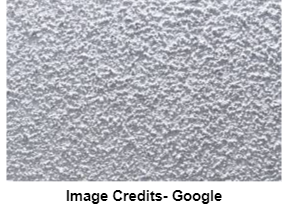
Popcorn wall textures have been around since the 70s for their excellent look even today. The justification behind this kind of texture's prominence is that it's extraordinary at concealing flaws, and it can even assist with subduing sound among floors and dividers.
Read Related Post- How to remove popcorn ceiling?
In any case, the best part about this way of finishing is its do-it-myself and direct appeal. All you need is the paint, an air blower, and a container.
The popcorn texture is a blend of drywall mud and polystyrene, and it arrives in a standard white tone, so it's ideal to be used on any wall. Blend the popcorn paint with water, adhering to the guidelines on the bundle, and install safely.
Try to cover all surfaces and things that are not to be splashed. When the rest of the room is appropriately protected, spray away the rest painted. The surface can be painted with any shading you need after it has dried.
2. Comb Wall Texture
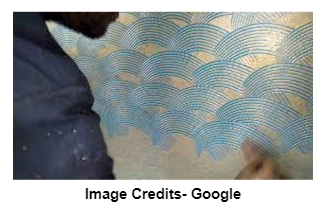
The comb-like wall texture can be achieved by making different widths and shapes lines in the drywall compounds. This procedure is regularly used to create a rehashed series of rainbow designs on the drywall and is one of the most simplified finishing touches for walls.
This technique requires a drywall compound, a roller, and a drywall scoop with uniformly divided teeth (or crooked teeth if you are going for a less coordinated example).
Apply the drywall compound to the divider utilizing the roller, then, at that point, use the teeth of the scoop to apply lines in the wet mixture tenderly.
If you focus on unique concentric circles, practice your imaginative abilities on an extra piece of the drywall before endeavoring them on your divider. Allow the surface to dry for 24 hours before preparing and painting.
3. Orange Peel Wall Texture
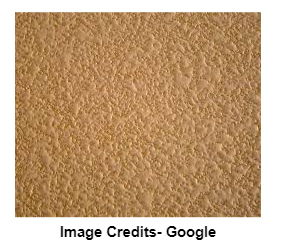
An orange peel wall texture looks as it sounds. You should start preparing for this texture early and ensure the wall surface is smooth and oil-free so that paint can adhere to it. Get a container with an air-flexible valve, an air blower, and a drywall compound.
Blend the drywall compound with water until it turns into the consistency of thick paint or a soupy flapjack player, then empty it into your container. Shower a modest quantity from the container onto a test piece and change the air valve to suit the splash design that you need.
You ought to shoot little splatters of a compound onto the divider to make the ideal surface, however not wholly covering the prepared drywall under. Attempt both substantial splatters and light splatters, and when you are sure about the splash design, start to apply it to the dividers; in the wake of drying, prime and paint the finished walls.
4. Knockdown Texture
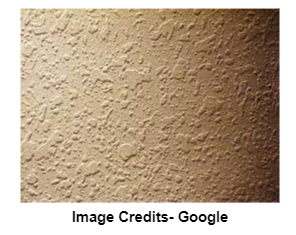
The knockdown method resembles much like the texture of the plaster. Knockdown texture can be accomplished by adding a stage to the orange strip method: After applying an orange strip surface to the desired consistency, straighten the pinnacles and knock that structure in the drywall compound utilizing a knockdown blade.
Bigger rooms will probably require a holding up time of around 10 to 15 minutes in the wake of splashing before the pinnacles can start to be straightened, while a more extensive room can most likely be begun when you are done showering.
Be cautious with timing! If you start straightening the drywall compound too soon, the knockdown blade will leave lines from the edges of the blade. And if you see this happening, stop and wait for five or 10 minutes.
5. Sand Swirl
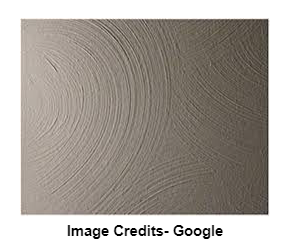
Sand swirl texture adds a vibe of unique style to your house interiors without asking for attention. Hold the paintbrush by the base, as this will give you more control than holding the handle. Dip the brush a couple of times into the paint, wiping it on one or the other side of the container to eliminate free dribbles.
Try to make a swirling design on an extra piece of the drywall before moving onto the wall. Use the brush, start at the actual top of the divider, making a central circle with an open base.
Each line of this swirl example will hide the lower part of the last column. Apply twirls to a 5-foot area, plunging the brush into the paint after each whirl, then, at that point, return to your beginning stage and drop down one line.
Keep working your direction around the room until you are finished; then, at that point, let it dry. Following a 24-hour drying period, you can prime and paint the dividers.
6. Slap Brush
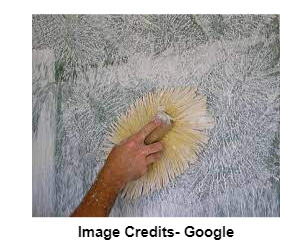
The slap brush wall texture makes a great example of a unique texture for your walls that can add an unconventional style to any room. All you need to achieve this texture is a roller, a twofold crow's foot drywall surface brush (otherwise called a slap brush, accessible on Amazon), and a drywall compound.
Blend your compound with water to get a thick consistency, then apply it evenly to the wall using the roller. Complete paint in batches to get the slap brush texture.
Apply drywall compound to each side of the slap brush in a thin layer, and afterward, start slapping the central portion of the wall with the brush. There is no hard and fast rule on which way you should start painting, so you can work your way either way you like.
When the main wall is covered, roll the following 5-foot space of the divider, and apply the slap brushing to the leftover sections. Repeat the steps until you have finished the room. Let the paint dry for 24 hours before priming the wall and paint the room.
Why Hire MGP Painting Services?
Our MGP painting experts continue to develop high-end services insisting upon durability and fewer environmental impacts. If you are searching for professional interior painting services, we suggest getting our expert consultation for your home painting projects that you have been procrastinating.
Mgp painting is a perfect solution to all your house painting needs. Let us paint your dreams and experience problem-free and smooth residential painting services that last longer. We are more than happy to help! Contact us @ Call 845.290.5284 for expert help.
Recent Posts
- Garage Floor Painters & Concrete Coating Experts Near You: What to Expect in 2025
- Business Painting Services That Mean Business: What to Expect from a Professional Commercial Painter
- What’s the Difference Between Commercial and Residential Painting Services?
- Types of Commercial Painting Services Explained: Interior, Exterior & Specialty Jobs
- Why Commercial Properties Need Specialized Painting Solutions
- Office Building Painting 101: Tips, Colors & Cost Guide
- Top Qualities to Look for in a Commercial Painting Company
- Interior vs. Exterior Commercial Painting: What Your Property Needs First
- Retail Painting Services: How to Keep Your Storefront Looking Fresh Year-Round
- How to Choose the Right Commercial Painting Contractor for Your Building
- Need Commercial Painting Experts Near You? Here's What We Offer
- Everything You Need to Know About Painting Interior Doors
- How Long Does Interior Paint Really Last (And How Often Should You Repaint?)
- Painting Cabin Interiors: Best Colors, Finishes, and Techniques
- Interior vs. Exterior Paint: What’s the Real Difference?
- Painted Hardie Board & Wall Texture Tips: What Homeowners in Cornwall Hudson Need to Know
- From Walls to Exteriors: Luxe Finishes with Foil Gold Wallpaper, Pre-Painted Hardie Board & Sherwin-Williams Products
- How Much Does It Really Cost to Sand Texture a Painted Wall?
- Vinyl Plank vs. Laminate Flooring: The Ultimate Homeowner's Guide
- Top Tips to Choose the Wall Texture Types for Your Home
- Affordable Painting Services Near Me: How Much to Paint a Bedroom and Other Home Painting Costs
- Affordable Painting Contractors Near Me: How Much Does It Cost to Paint a House Exterior?
- How to Save on Painting a Two-Story House: Affordable Painting Contractors in Your Area
- How Much Does It Cost to Paint a Room? Find Affordable Painters Near You
- Interior House Painting in Bergen & Rockland County – Done Right
- Can You Use Interior or Exterior Paint in the “Wrong” Place?
- How Long After Washing Walls Can You Paint? Plus, Expert Help from MGP Painting
- Why Hiring Professional Painters is the Best Decision for Your Home or Business?
- Why Hiring Professional Painters is Key to Stunning Venetian Plaster Walls?
- Why Choose Professional Painters for Your Interior Painting in Westchester County, NY?
- Why a Fresh Coat of Paint is the Perfect Gift for Your Home This Holiday Season?
- The Best Crown Molding Ideas for Your Mobile Home
- When to Use Elastomeric Paint on Stucco Surfaces?
- How Whitewashed Brick Can Give Your Rockland House a Stylish, Modern Vibe?
- The Ultimate Guide to Cleaning and Staining Cedar Siding
- How MGP Painting Resolves Exterior Painting Issues in Allendale, Ardsley, and Baldwin Place?
- How to Choose the Perfect Rustic Barn Colors for Your Property?
- Painting James Hardie Siding: The Best Exterior Paint for Painting Fiber Cement Siding
- Wood vs. Vinyl Siding: A Comprehensive Comparison
- Paint or Replace Vinyl Siding: Which Option is Right for Your Home?
- Embrace Fall 2024 with Trendy Home Colors: Insights from Magnolia Homes and Sherwin-Williams
- Trending Colors in Residential Interior Painting for 2024
- The 3 Biggest Mistakes Westchester Homeowners Make in DIY Kitchen Cabinet Painting
- Top 5 Painting Tips To Get Your Rockland Home Holiday-Ready
- Why Choose a Professional Interior-Exterior House Painting Contractor in Westchester County, NY
- 5 Tips for Choosing the Right House Painter in Bergen County, NJ
- What is the average cost to remove wallpaper in Rockland County?
- How much does it cost to hire an interior painter?
- How much does it cost for interior painting in Westchester County, NY?
- Cost of Painting Kitchen Cabinets Vs Replacing them | A Detailed Comparison
- How Much Does it Cost to Paint Kitchen Cabinets in 2022?
- Five Common Problems Professional Wallpaper Installers Face
- Time Saving Tips For Easy Foil Wallpaper Installation
- What to Expect from MGP’s Professional Wallpaper Installation Service In Westchester?
- Is Prepasted Wallpaper Installation Easy?
- Why is Grasscloth Wallpaper Installation Service so expensive?
- Professional Wallpaper Installers Near Westchester County-An MGP Painting Guide
- Kitchen Cabinets Painting Costs In 2022- MGP Painting
- Why was Popcorn Ceiling Popular?
- What is the Average Wallpaper Removal Cost Per Room?
- New Construction: How to Choose Best Paint Colors For Your Westchester Home?
- Warehouse Ceiling: Best Painting Options
- WALLPAPER INSTALLATION SERVICES - MGP PAINTING
- Masking Tape: Painting Techniques for a Flawless Paint Job
- Wall Mural Painting Ideas
- Laminate Flooring v/s Vinyl Flooring
- Different Types of Wall Textures
- How Much Commercial Paintings Cost?
- Eco-Friendly Paints: Brands You Should Try and Why People Love Them.
- How Long Does a Paint Job Last?
- Spray Paint vs. Brush Paint. Which is Better?
- How to Spray Paint a Metal Bed Frame?
- What is The Best Paint Type for Bathroom Walls
- How to Paint Over Outdated Wood Kitchen Cabinets?
- Types of Epoxy Flooring and Epoxy Installation Process
- How to Dispose of Old Paints?
- How Long After Washing Walls Can You Paint?
- How to choose ceiling colors for your living room accentuating walls?
- Wallpaper vs Paint: Which one is a better option for walls?
- How to Ensure Child Safety While Painting Your House?
- What is the difference between Venetian plaster and regular plaster?
- The Benefits of Deck Paint and How to Increase the Longevity of Your Deck?
- What is the best benefit of epoxy flooring?
- What is the best way to remove existing finishes from wooden decking?
- What Are The Benefits Of Hiring An Epoxy Flooring Contractor?
- Five Benefits Of Hiring A Professional Interior Painting Contractor
- How to Fix Painting Mistakes on Walls?
- Which Season Works Best For House Exterior Painting
- How To Remove Popcorn Ceiling?
- How Often Should You Paint The Exterior Of Your House
- Best Way To Clean Walls Before Painting
- How much does it cost to repaint kitchen cabinets?
- Fall In Love With Your Walls This Season
- When Is It Time to Paint? (Pssst… Now!)
- Prepare Your Home For Summer
- Do’s and Don’ts of Painting When You Want to Sell Your House
- Paint Your Home Like a Pro with These 5 Painting Rules
- Your Interior Colors can Affect Your Mood
- Need a Power-Washing or a Pressure-Washing?
- Affordable, Trendy Designs, at Attractive Prices
- How Painting Can Improve Your Home’s Value
- Why Yearly Deck Maintenance is Important
- 5 Things to Know When Choosing a Paint Color
- Local vs. National: Why Hire Close to Home?
- Pre-painting Tips from the Experts at MGP
- How the Professional Residential Painting Services Are Perfect for Your Home


